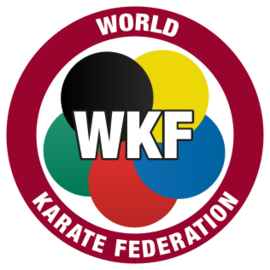World Karate Federation facts for kids
 |
|
| Sport | Karate |
|---|---|
| Jurisdiction | Worldwide |
| Membership | 200 |
| Abbreviation | WKF |
| Founded | 10 October 1970 |
| Affiliation | IOC |
| Regional affiliation | World |
| Headquarters | Madrid |
| Location | Spain |
| President | Antonio Espinós of Spain |
| CEO | Sara Wolfferdown |
| Vice president(s) | Jose Garcia-Maañón, Nasser Alrazooqi, Bechir Cherif, Gunnar Nordahl, Michael Kassis, Wolfgang Weigert |
| Official website | |
The World Karate Federation (WKF) is a big organization that manages sport karate around the world. It has 200 member countries and over 100 million members! The WKF is the only karate group officially recognized by the International Olympic Committee. This means they are the main people in charge of karate as a sport.
The WKF organizes major events like the Junior and Senior Karate World Championships. These exciting competitions happen every two years. The current President of the WKF is Antonio Espinós, and their main office is in Madrid, Spain.
Contents
The History of World Karate Federation
Karate first came to Europe around the 1950s. Japanese masters from groups like the Japan Karate Association helped introduce it. In 1961, Jacques Delcourt became the President of the French Karate Federation.
In 1963, he invited other European karate groups to France. These groups were from Italy, Great Britain, Belgium, Germany, Switzerland, and Spain. Great Britain and Belgium accepted the invitation. Later that year, six of these groups met in Paris. This was the first European Karate Congress. They wanted to make karate tournaments better and more organized. They realized that different karate styles couldn't be fully combined. So, they decided to make the refereeing rules the same for everyone.
Forming the European Karate Union
By 1963, the European Karate Union (EKU) was created. Jacques Delcourt was chosen as its first President. The very next year, the first European Karate Championships were held in Paris.
Creating a World Organization
In 1970, Jacques Delcourt also started the International Karate Union (IKU). His goal was to organize karate at a worldwide level. When Ryoichi Sasakawa, the President of a Japanese karate group called FAJKO (which later became the Japan Karate Federation or JKF), heard about this, he traveled to France. They talked about creating one big international group for karate.
The IKU was soon replaced by a new organization. This new group was formed by the EKU and the Japanese federation. They called it the World Union of Karate-do Organizations (WUKO).
WUKO Becomes WKF
In 1985, the International Olympic Committee officially recognized WUKO. This meant WUKO was the official group for karate. During the 1990s, many new organizations joined WUKO. Its membership grew to 150 national groups. Because it had grown so much, a new name was needed to show its size. So, on December 20, 1992, WUKO changed its name to the World Karate Federation (WKF).
The WKF continued to grow and became a strong organization. It truly represented sport karate around the world. In 1999, the IOC officially confirmed that the World Karate Federation was the only main group for karate globally.
A big moment for karate happened in August 2016. It was announced that Karate would be part of the 2020 Summer Olympics. This was a huge step for the sport!
WKF Members Around the World
The World Karate Federation has 200 national member groups. These groups are spread across five different continents.
Continental Federations
These are the main karate groups for each continent:
| Continent | Name | Abbreviation | National Member Federations |
|---|---|---|---|
| Africa | African Karate Federation | UFAK | 50 |
| Asia | Asian Karate Federation | AKF | 44 |
| Europe | European Karate Federation | EKF | 54 |
| Americas | Panamerican Karate Federation | PKF | 39 |
| Oceania | Oceanian Karate Federation | OKF | 13 |
Karate Competitions and Events
The WKF organizes different types of karate competitions. These events test athletes' skills in various ways.
Kumite (Sparring)
Kumite is like sparring or fighting against an opponent.
- Individual kumite for Men: Athletes compete in different weight categories (e.g., -60 kg, -67 kg, -75 kg, -84 kg, and +84 kg).
- Individual kumite for Women: Athletes compete in different weight categories (e.g., -50 kg, -55 kg, -61 kg, -68 kg, and +68 kg).
- Team kumite: Teams of men or women compete together.
Kata (Forms)
Kata involves performing a series of movements against imaginary opponents. It shows skill, balance, and power.
- Individual kata for Men and Women.
- Team kata (synchronized): Teams perform kata together, making sure their movements are perfectly in sync.
- Team kata with bunkai: This includes showing the practical meaning of the kata movements.
Para-Karate (For Athletes with Disabilities)
Para-Karate allows athletes with disabilities to compete.
- Athletes with Visual Impairments: Men and Women
- Athletes with Intellectual Impairments: Men and Women
- Wheelchair Users: Men and Women
See also
 In Spanish: Federación Mundial de Karate para niños
In Spanish: Federación Mundial de Karate para niños

